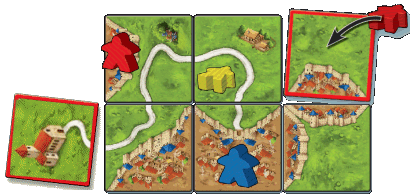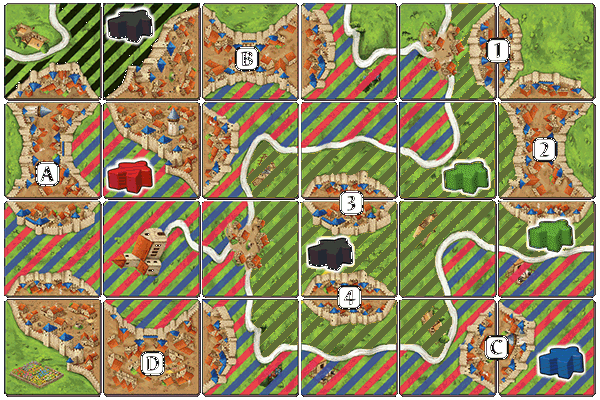Carcassonne: Understanding Farms
Farms gain points per completed city they can supply. This means they rely on cities being built and completed for starters; however, they are also reliant on others not getting in on your farm action. If two players, throughout the course of the game, begin to share a farm with equal numbers of farmers apiece, then they both get the points. If, however, one player manages to get more farmers then they take all the points accumulated by that farm. Why is this risky? Once you place a farmer you cannot remove and replace it throughout the game. With that in mind, the farm strategy has become considered as the riskiest strategy in the Carcassonne repertoire.
You draw a tile, and
must place it in such a way that the edges of the tile match
the edges of the tiles already in play. Fields always refer
to the green spaces found in the landscape of Carcassonne.
In determining field size, fields can be limited by all kinds
of barriers, for example, roads, cities, or rivers which
cannot be circumvented, or the edge of the playing field.
It can certainly happen that a field covers almost the
entire playing field, and there will likely be fields
that remain open for the entire game.
A farmer is a meeple that you
place “laying down” in a field segment. Unlike highwaymen, knights,
and monks that are all placed standing up, farmers are laid down on
a tile because they are only scored at the end of the game.
Consequently, they are not returned to your supply until the final
scoring takes place.
Laying farmers down ensures that you remember to leave them on the board. As always, you can only place your farmer if there are no other farmers in the field. The fields of Carcassonne are divided by roads, cities, or anything else that clearly split them visually such as a river.
Farms can become very
valuable, or they can remain worthless. Either way, tying
up a meeple until the end of the game can result in the
loss of points.
 Joining Farms
Joining Farms
Placing the top right tile allows red to claim the northern farm
because it is separated from yellow’s farm by the road. Later in
the game, when the Monastery is added, it terminates the road and
the farm now runs around the left edge of the Monterey tile and
joins the yellow and red farms together. Both players have one
farmer in that farm, so they will both get the points at the end
of the game.
Stealing a Farm
If either player decides to perform the same action later in the
game, adding a second farmer to this farm, they now outnumber the
other farmer 2 to 1, and they will get all of the points while the
other farmer gets nothing.

As mentioned previously, farmers are
not scored during the game and, consequently, they do not return
to your supply. So place your farmers wisely. Now, let’s assume
the game is over and that we are conducting the final scoring.
Unlike other features, it is not the field tiles that are counted,
but the number of completed cities that border a field. Each
completed city that touches a field adds 3 points to the value
of that field. All fields touched by a city will see their value
increased by 3 points.
Similar to roads and cities, if there is more than one farmer
in the same field, only the player with the most farmers in that
field scores its points. In the case of a tie, each tied player
scores full points.
The Black farm in the top left corner is limited by the edge of the map, the road, and the edges of the two city tiles. Both of the two cities that farm touches, A and B, are complete cities, so Black will receive 6 points. The Red/Blue farm is an example of two joined farms. It is rather extensive and is limited again by the edges of the map, plus multiple road and cities. This farm touches four cities, A B C and D, but D is an incomplete city so Red and Blue will only receive 9 points, 3 points each for A B and C, zero points for D. The Green farm is an example of a stolen farm. The farm was originally owned jointly by Black and Green, but Green was able to join a second meeple to the farm so he now controls the farm 2 meeple to 1 and will get a total of 12 points for each of the 4 completed cities that the farm touches, while Black gets 0 points.
The Pig makes your Farm more Valuable
Pigs make farms more valuable. You can have multiple farms in a game, but you only have one pig.
The Barn - Score your farm now AND later!
The barn is a very important enhancement for your farms. Each player can only have one barn, so it is impossible for one player to steal a barned farm from another, but it is possible for multiple players to share the same barned farm. The most important feature of the barn is that once it is placed, you get your farmer meeples and your pig back!
Bridges - How to connect farms across roads
Bridges can be extremely useful in building and expanding your farm, because you can use a bridge to connect the farmland on both sides of a road.